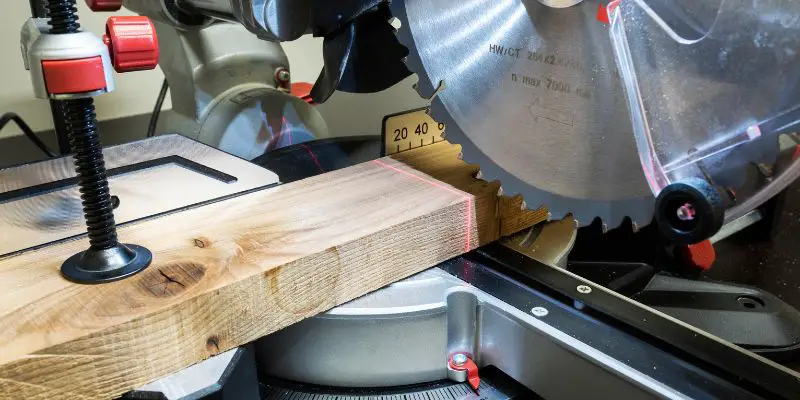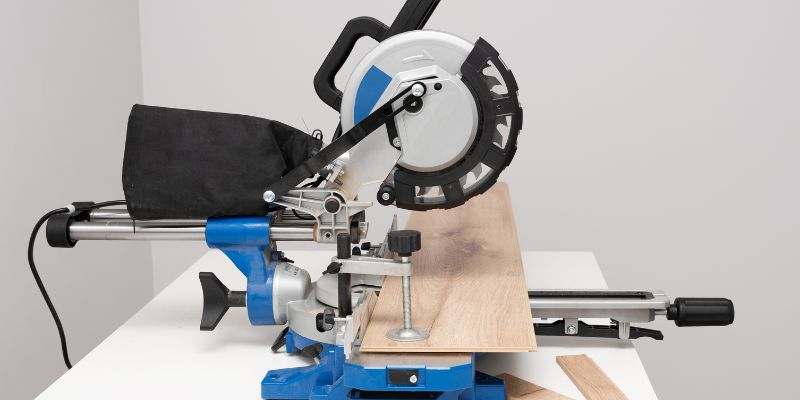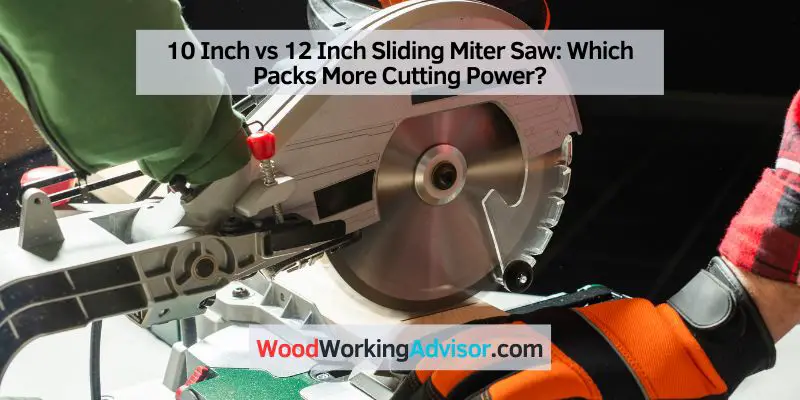A 10-inch sliding miter saw is smaller and lighter than a 12-inch sliding miter saw, making it more portable and easier to handle. With its smaller blade size, it is suitable for precision cutting and can be a good option for hobbyists and DIYers.
However, a 12-inch sliding miter saw offers a larger cutting capacity, making it ideal for professionals and contractors who work with larger pieces of wood or need to make longer cuts. It provides more versatility and power for demanding projects.
Both saws have their advantages and it ultimately depends on the specific needs and preferences of the user.
Comparing The Basics
When it comes to choosing the right sliding miter saw for your woodworking projects, there are a few key factors to consider. Two common options are the 10-inch and 12-inch sliding miter saws. In this article, we will compare the basics of these two types of saws to help you make an informed decision. Let’s start by examining their size and weight.
Size And Weight
The size and weight of a sliding miter saw can play a significant role in your woodworking projects. Here’s a comparison:
| Saw Type | Size | Weight |
|---|---|---|
| 10 inch sliding miter saw | Smaller | Lighter |
| 12 inch sliding miter saw | Larger | Heavier |
The 10-inch sliding miter saw is generally smaller and lighter in comparison to the 12-inch counterpart. This makes it easier to maneuver and transport, ideal for those who frequently work on different job sites or have limited workspace in their workshop.
On the other hand, the 12-inch sliding miter saw is larger and heavier. This increased size and weight provide stability and strength, making it suitable for working with larger and tougher materials. If you often deal with thick hardwoods or need to cut wider pieces, the 12-inch sliding miter saw may be the better choice for you.

Cutting Capacity
The cutting capacity of a sliding miter saw refers to the maximum size of stock it can handle. Let’s explore it further:
- 10-inch sliding miter saw: With its smaller blade, this saw generally has a maximum crosscut capacity of around 6 to 7 inches. This means it can effectively tackle most trim work, crown molding, and other small to medium-sized woodworking projects.
- 12-inch sliding miter saw: Thanks to the larger blade, this saw typically offers a greater cutting capacity, capable of handling wide boards up to 8 or even 12 inches in width. If you frequently work with larger materials or need to make broader cuts, the 12-inch sliding miter saw provides the necessary reach.
Considering the cutting capacity is crucial, as it determines the range of projects you can efficiently accomplish with your sliding miter saw.
In conclusion, the choice between a 10-inch and 12-inch sliding miter saw depends on your specific woodworking needs. If you prioritize portability and have smaller-scale projects, the 10-inch option may be the right fit. However, if you require the ability to handle larger materials and make wider cuts, the 12-inch sliding miter saw will provide the versatility you need. Evaluate your requirements and choose wisely to ensure seamless and precise cutting in your woodworking endeavors.
Cutting Power And Performance
Comparing 10-inch and 12-inch sliding miter saws for cutting power and performance. Find out which size can provide the precision and versatility you need for your woodworking projects.
Motor Power And RPM
When it comes to cutting power and the performance of a sliding miter saw, two important factors to consider are motor power and RPM (rotations per minute). These factors determine the saw’s ability to cut through different materials with ease and precision. Let’s take a closer look at how motor power and RPM affect the performance of 10-inch and 12-inch sliding miter saws.
Motor Power
The motor power of a sliding miter saw is measured in amps, and it directly affects the saw’s cutting ability. A higher motor power means more cutting power, allowing you to tackle tougher materials effortlessly. A 10-inch sliding miter saw typically has a motor power between 10-15 amps, while a 12-inch sliding miter saw often has a motor power ranging from 15-20 amps. With a higher motor power, the 12-inch saw is capable of producing more cutting force, making it ideal for heavy-duty cutting tasks.
Rpm (rotations Per Minute)
The RPM of a miter saw refers to the number of rotations the blade makes in a minute. It directly affects the cutting speed and efficiency of the saw. A higher RPM allows the blade to rotate faster, resulting in smoother and faster cuts. While both 10-inch and 12-inch sliding miter saws generally have similar RPM ranges (around 4,000-5,000 RPM), the larger blade size of the 12-inch saw can lead to slightly slower RPM. However, this does not significantly impact its cutting performance. Despite the slightly lower RPM, the larger blade compensates by covering more cutting area, making it an excellent choice for larger cutting tasks.
Overall, both 10-inch and 12-inch sliding miter saws offer sufficient cutting power and performance. However, if you frequently work with thicker and harder materials, the 12-inch sliding miter saw with its higher motor power may be a better option. Additionally, the larger blade size provides a wider cutting area, making it more versatile for various projects. Consider your specific cutting needs and materials before choosing between the two sizes.
Versatility And Flexibility
When it comes to choosing a sliding miter saw, one of the key factors to consider is its versatility and flexibility. A miter saw that offers a wide range of bevel and miter angles, as well as being easy to use and portable, can greatly enhance your woodworking experience. In this article, we will compare the 10-inch and 12-inch sliding miter saws in terms of their versatility and flexibility, focusing on two main aspects: bevel and miter angles, and ease of use and portability.
Bevel And Miter Angles
Bevel and miter angles play a crucial role in the versatility of a sliding miter saw. The ability to make precise bevel cuts allows you to create angled edges, perfect for various woodworking projects such as crown molding or picture frames. Additionally, the miter angle adjustment enables you to make accurate angled cuts, whether it’s for creating tight corner joints or custom miters.
Both the 10-inch and 12-inch sliding miter saws offer a wide range of bevel and miter angles. However, the 12-inch saws generally have a slightly greater cutting capacity, allowing you to work with larger or thicker materials. This added capacity gives you more flexibility in tackling different projects and ensures you can make accurate cuts even on larger pieces of wood.
Ease Of Use And Portability
Another important aspect to consider when comparing 10-inch and 12-inch sliding miter saws is their ease of use and portability. A saw that is easy to set up and adjust makes your woodworking tasks much more efficient, saving you time and effort. Portability is also crucial, especially if you frequently move your saw between job sites or have limited workshop space.
The 10-inch sliding miter saws are generally more compact and lightweight, making them easier to transport and store. They are also typically more user-friendly, making them suitable for beginners or DIY enthusiasts. On the other hand, the 12-inch sliding miter saws offer a larger cutting capacity, which can be advantageous for professional woodworkers or those working with larger materials.
Ultimately, the choice between a 10-inch and 12-inch sliding miter saw depends on your specific needs and preferences. If you prioritize portability and ease of use, the 10-inch saw may be the better option. However, if you require a larger cutting capacity and are willing to sacrifice some portability, the 12-inch saw may be the right choice for you.

Price And Value
When it comes to choosing between a 10-inch and a 12-inch sliding miter saw, one crucial factor that can greatly influence your decision is the price and value of each option. Understanding the cost comparison and evaluating the value for money is essential to make an informed choice. In this section, we will explore the price differences between these two types of sliding miter saws and delve into the value they bring to the table.
Cost Comparison
Let’s begin by comparing the costs of a 10-inch and a 12-inch sliding miter saw. In general, the 10-inch models tend to be more budget-friendly, making them an attractive option for those who are conscious of their spending. These compact yet versatile saws offer a good balance between price and performance, making them a popular choice among DIY enthusiasts and hobbyists.
On the other hand, 12-inch sliding miter saws are usually priced higher due to their larger size and increased cutting capacity. These robust tools are designed for professionals and individuals who often tackle more demanding projects. While the initial investment may be higher compared to a 10-inch model, the extended capabilities and durability make them an excellent long-term investment for those who require precision and power in their woodworking endeavors.
Value For Money
When assessing the value for money, it’s important to consider the features and benefits each size provides. Let’s explore the value proposition of both options:
| 10-Inch Sliding Miter Saw | 12-Inch Sliding Miter Saw |
|---|---|
|
|
Ultimately, the choice between a 10-inch and a 12-inch sliding miter saw boils down to your specific needs and budget. If you primarily handle smaller projects and are looking for a cost-effective option, the 10-inch model can provide excellent value for money. However, if you work on larger projects or require more cutting capacity and power, investing in a 12-inch sliding miter saw offers long-term value with its enhanced capabilities and durability.
Frequently Asked Questions On 10 Inch Vs 12 Inch Sliding Miter Saw
Is A 10 Or 12-inch Miter Saw Better?
The choice between a 10 or 12-inch miter saw depends on your needs. A 10-inch saw is lighter and more portable, while a 12-inch saw can cut larger materials. Consider the size of your projects and workspace to determine which is better suited for you.
What Size Sliding Miter Saw Is Best?
The best-sized sliding miter saw depends on your specific needs and projects. Consider the cutting capacity and the size of the material you usually work with. A 10-inch sliding miter saw is versatile for most woodworking tasks, while a 12-inch saw offers a larger cutting capacity for bigger projects.
How Wide Can A 10-inch Sliding Miter Saw Cut?
A 10-inch sliding miter saw can cut up to 10 inches wide, making it suitable for a variety of projects.
Do I Need A 12 In Sliding Miter Saw?
Yes, a 12-inch sliding miter saw can be a valuable tool for woodworking and other projects. Its larger blade size allows for cutting larger stock and offers more flexibility in handling different materials. Upgrade to a 12-inch sliding miter saw if you work with larger pieces or need increased cutting capacity.
Conclusion
To sum it up, choosing between a 10-inch and a 12-inch sliding miter saw ultimately depends on your specific needs and requirements. While a 10-inch saw may be suitable for smaller projects and lighter materials, a 12-inch saw offers a wider cutting capacity for larger projects and heavier materials.
Consider the types of projects you typically work on and the materials you use most frequently to make an informed decision. Ultimately, the right miter saw for you is the one that best aligns with your specific needs.


